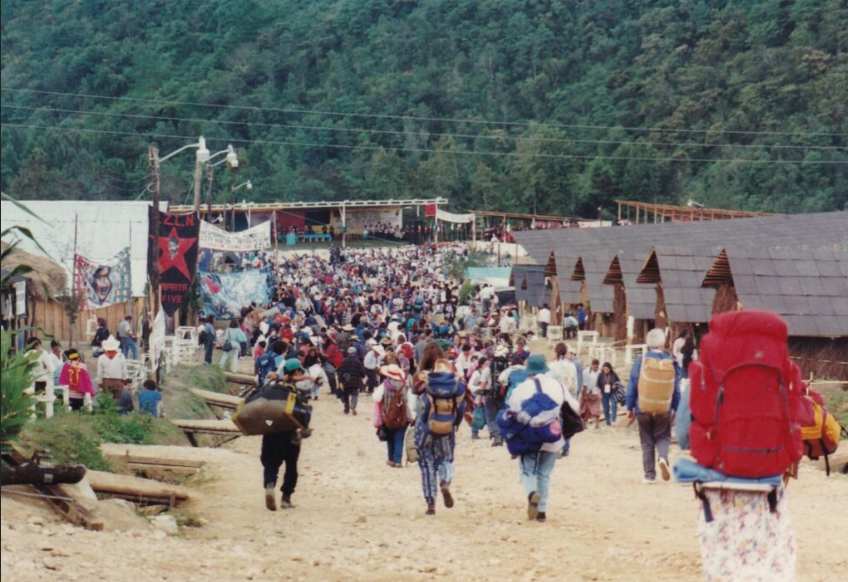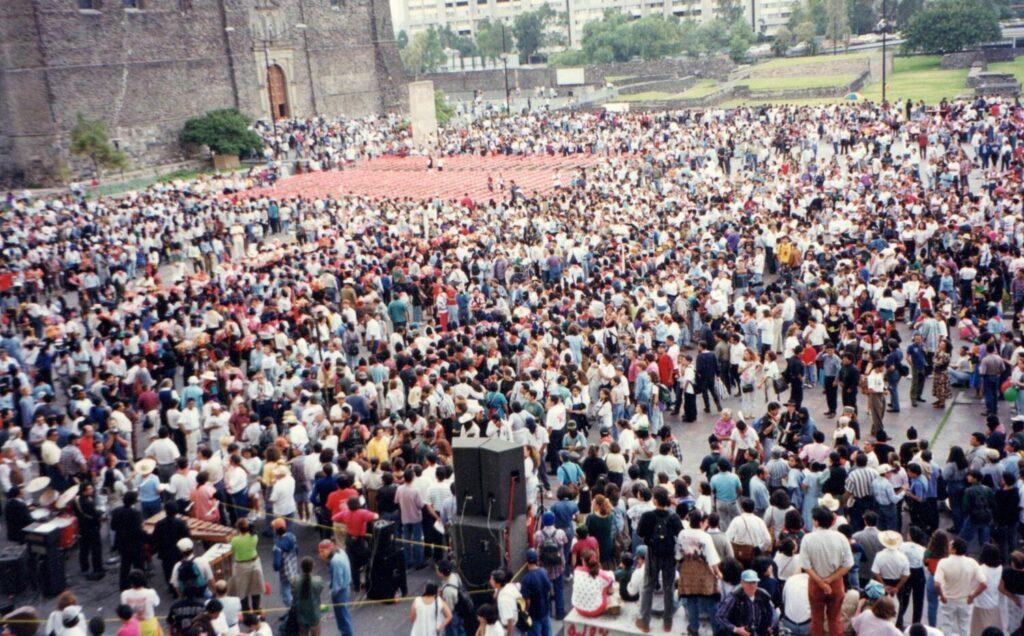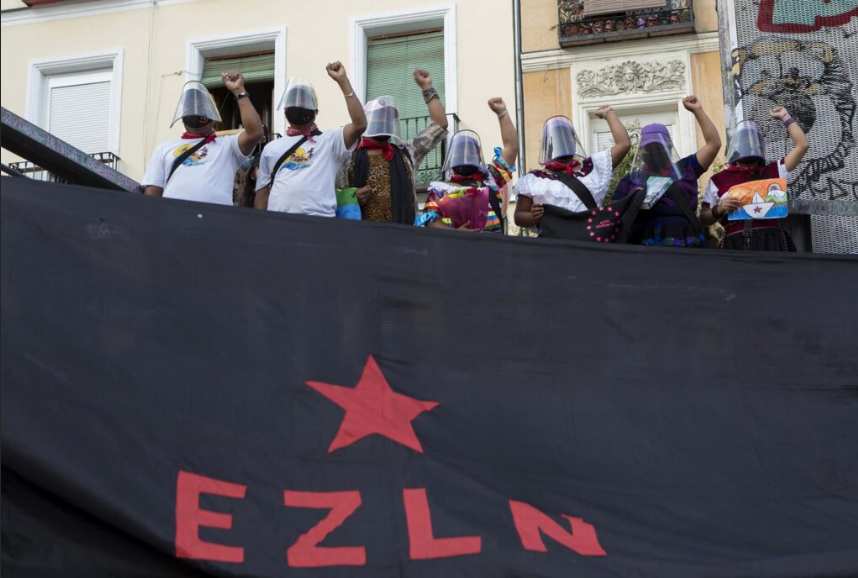
The EZLN has made multiple rapprochements with Mexican and international civil society during all these years. The Zapatista initiatives have always been to create spaces of encounter and resistance against capitalism and to weave networks for life.
Since the public appearance of the EZLN on January 1, 1994, much has been said about the relationship it has maintained with the so-called Mexican and international civil society. Both have been very important not only because of their support to the Zapatista resistance, but also because they have been a catalyst for the struggles in different territories. This relationship has evolved in different ways over the years; there were those who, with the passage of time, distanced themselves and even became very critical of Zapatismo; others, however, came to know Zapatismo later, thanks to the different initiatives of the rebels, such as the Intergalactic Encounters, festivals like “La Digna Rabia”, or more recently, the Zapatista Tour, in 2021. Many others have remained close to the Zapatista struggle since its beginnings.
The emergence of the EZLN as an indigenous army fighting for a more just and dignified society for everyone and not for the conquest of power, caused different sectors of Mexican and international civil society to approach them. After the fall of the Berlin Wall and the signing of peace agreements by the Central American guerrillas, part of the left found in Zapatismo, with its novel proposals for changing the world, references for the struggles in their own places. These people had different backgrounds: militants of social, union and political organizations, men and women who had not previously been militants, intellectuals, artists and other cultural people; it was the time when people wanted to go to Chiapas to get to know this revolution in the Mexican southeast. The political and social proposals that the Zapatistas summarized in three words that used to close the communiqués of the time: democracy, freedom and justice, were very well received by broad sectors of society.
After the first days of fighting, civil society took to the streets demanding an end to the war and that agreements be reached through negotiation. At that moment, both parties accepted a ceasefire and sat down to dialogue. The first contacts of the EZLN with civil society were made through communiqués signed by the then Subcomandante Marcos, which allowed us to know a little more about the life of the support bases in the communities and of the insurgents in the mountains. Little by little, they began to write and reply to indigenous, social and student organizations, among others, who in different ways sent them letters, questions and doubts.
This rapprochement had its first moment with the “Cathedral Dialogues” in San Cristóbal de las Casas, as Sup Marcos himself acknowledged to Yvon Le Bot in his book “The Zapatista Dream”. To avoid possible attacks on the Zapatista delegation, civil society was asked to participate in the “peace belts” around the Cathedral. The response of men and women, most of whom did not belong to any organization, was very numerous.
During the first years after the Zapatista uprising, the people who supported or collaborated with the proposals they presented, and who created numerous groups and support committees, both in Mexico and internationally, were of a very wide ideological range, ranging from sectors of social democracy, which even participated in parties such as the PRD, to sectors more to the left, such as communists and anarchists. It was easy to find in the same collective, very diverse people who saw in Zapatismo a new way of doing politics. But some of these sectors became more and more distant and even criticized the EZLN’s refusal to support López Obrador years later, despite the fact that López Obrador, with his Fourth Transformation policy, is carrying out proposals such as the Mayan Train or the Morelos Integral Project, which are a frontal attack on the native peoples.
The relationship between the EZLN and Civil Society has been very diverse in its forms and proposals over the last 30 years, and has developed through a wide variety of meetings, seminars, workshops and festivals. The first meeting to be highlighted, after the Cathedral Dialogues, was the convening, in Zapatista territory, of the National Democratic Convention, in August 1994. It was attended by several thousand men and women from social and leftist organizations seeking a form of coordination for a greater democratization of Mexico. The EZLN brought them together in its first Aguascalientes, in Guadalupe Tepeyac. In that place, built by the support bases and Zapatista insurgents, there was a large auditorium, a library, places to sleep, kitchens, etcetera. From the first moment, Subcomandante Marcos and the Zapatista Command handed the place over to the Civil Society.
This first Aguascalientes was destroyed by the soldiers of the federal army when, on February 9, 1995, they entered the communities looking for the Zapatistas and mainly their leadership who had been able to flee to the mountains. On that famous day, the government of Ernesto Zedillo betrayed them by breaking the dialogue they were maintaining and arresting several people accused of belonging to the EZLN. Thanks to the mobilization of thousands of people in Mexico and the rest of the world, the government was able to stop the resumption of the war and was forced to continue with the dialogue. This dialogue, known by the name of the place where it was held, San Miguel, and later those held in the municipality of San Andrés Larráinzar, called San Andrés Sacamch’en de los Pobres by the Zapatistas, also included the participation of civil society as “peace corridors” at the invitation of the EZLN.
Although during all these years, the EZLN maintained direct and continuous contact with civil society through very diverse invitations, it is from 1996 onwards when this relationship broadens and has a greater participation of international civil society, through the collectives of support for Zapatismo that had been emerging all over the planet.
We must remember the I and II Intercontinental Encounter for Humanity and against Neoliberalism. The first of these took place at the end of July and beginning of August 1996, in Zapatista territory, in the five Aguascalientes (Oventik, La Garrucha, Morelia, Roberto Barrios and La Realidad) created after the destruction of the Guadalupe Tepeyac in 1995. After the inauguration in Oventik, the more than 5,000 people in attendance split up and traveled to each of the Aguascalientes, where for several days, they discussed how to build a new world in political, economic, social, cultural, diversity and identity aspects. Before the closing of the Encounter, it was proposed to hold the Second Encounter in Spain the following summer.
Again, with a high participation, several thousand people reflected and shared proposals, to which were added the words of the Zapatista Command, through two support bases, Dalia and Felipe, who, for the first time, left Mexico to be present at this Encounter. We had to wait 24 years to see an EZLN delegation in Europe again.
To these two large and massively-dattended meetings, meetings, others were added in the following years, such as the I and II “Meeting of Civil Society with the EZLN” in 1998 and 1999, the first of them in San Cristóbal de las Casas to prepare the Consultation for the Recognition of the Rights of the Indigenous Peoples and for the End of the War of Extermination, which had a national and international character and took place on March 21, 1999. In the days prior to the Consultation, 5,000 Zapatista delegates and support bases were deployed throughout the country. After this great mobilization, the Second Meeting with Civil Society was held in the community of La Realidad, Chiapas, for its evaluation.
In 2005, after a long internal debate, the EZLN published the Sixth Declaration of the Lacandon Jungle. In it, after evaluating all the work carried out since the uprising, they made a new political proposal, in which they emphasized that, in addition to continuing their struggle for the rights of indigenous peoples, this would be extended to the peoples and people who struggle in Mexico and the rest of the planet against neoliberalism. To this end, they propose a new organizational search, where everyone can meet and participate. The EZLN decides, among other agreements, the dissolution of the Zapatista National Liberation Front (a civil space for Zapatista participation), and the convening of a series of preparatory meetings and encounters with indigenous peoples, social organizations, unions, leftist political parties, NGOs, artists and individuals. The proposal they make is that those who agree with the Sixth Declaration, both collectively and individually, nationally and internationally, adhere to the Declaration and together discuss how to draw up a National Program of Struggle, left-wing and anti-capitalist; to this end, the tour of “The Other Campaign” was carried out during 2006 and 2007. This tour, which toured all of Mexico, was begun by Subcomandante Marcos (known as Delegate Zero) and subsequently, various Zapatista Comandantes and Comandantas joined in.
Other meetings were also held, such as the Encounters of the Zapatista Peoples with the peoples of the world, in 2006 and 2007, the Encounter of the Indigenous Peoples of America in 2007, or the two “Encounters of Women who Struggle”, both in the Caracol of Morelia in 2018 and 2019, in which thousands of women from all parts of the world participated.
These were not the only Encounters in which the EZLN called on civil society; we must also remember, the Political, Sports, Cultural and Artistic Event “Mamá Corral” (2009), the First World Festival of Dignified Rage (2008-2009), the “Tata Juan Chávez Alonso” Chair (2013), the CompArte and the ConCiencias por la humanidad (2016, 2017 and 2018), the Film Festivals “Puy ta Cuxlejaltic” in 2018 and 2019, the First Dance Festival “Báilate otro mundo” in 2019 and, above all, the calls to the “Escuelita Zapatista” in 2013 and 2014, where people lived with the Zapatistas, in their homes, as a way to know, in depth, how they live autonomy, day by day.
 EZLN sympathizers at a farewell rally for the caravan of the 1,111 Zapatista villages. September, 1997. Photo: CEDOZ
EZLN sympathizers at a farewell rally for the caravan of the 1,111 Zapatista villages. September, 1997. Photo: CEDOZAlso very important in these years were the marches and tours that the Zapatistas carried out. We have already mentioned the departure of the 5,000 Zapatistas for the 1999 Consultation and the one carried out in “The Other Campaign”, but there were many more: the trip of the 1,111 Zapatista compañeros and compañeras to attend, in September 1997, the Founding Congress of the FZLN. 111 Zapatista compañeros and compañeras to attend, in September 1997, the Founding Congress of the FZLN, in Mexico City; the “March of the Color of the Earth” in 2001, in which a delegation of the EZLN Command, accompanied by Subcomandante Marcos, traveled through several southern states of the country, from San Cristóbal de las Casas to Mexico City, to defend the constitutional reforms agreed upon in the San Andrés Accords, being received with great acts of support throughout the journey, culminating with the multitudinous reception in the Zócalo of Mexico City on March 11, and which had its climax on March 28, with the presence of the Zapatista Delegation, together with another from the National Indigenous Congress, in the Congress of the Union, where the central message was given by Comandanta Esther. This march included an important participation of the international civil society that accompanied the trip of the Caravan, formed by Europeans, among which the Italian and Spanish delegations stood out.
And we cannot forget, because of its great importance, the Tour for Life, carried out in 2021, in which a large Zapatista delegation toured Europe in order to learn more about the struggles taking place in these countries. From the announcement of the tour until its completion, various collectives coordinated to receive them and accompany them on their journey, with the particularity that they were not only European collectives supporting the Zapatistas, but also numerous organizations of all kinds, as well as individuals, who first received the “Squadron 421”, Lupita, Carolina, Ximena, Yuli, Bernal, Felipe and Marijose, four women, two men and one “otraa”, who arrived in Vigo aboard the ship “La Montaña” and then, in mid-September, the “La Extemporánea”, formed by 177 delegates, including the women’s soccer team Ixchel Ramona (named after the late Comandanta Ramona, the first Zapatista to leave Chiapas) and the Comando Palomitas, formed by 6 girls and boys. For several months they were spread throughout Europe where they met and got to know all that organized and diverse civil society, ready to change this world. At the beginning of December, they regrouped in Madrid to return to Mexico and to their towns and communities.
 Escuadrón 421 in the Plaza Antonio Barea in the Lavapiés neighborhood, on its way through the city of Madrid during the Zapatista Tour.
Escuadrón 421 in the Plaza Antonio Barea in the Lavapiés neighborhood, on its way through the city of Madrid during the Zapatista Tour.Photo: ELVIRA MEGÍAS
This “list of relationships” would be incomplete without mentioning the specific ones that the Zapatistas have had with the native peoples, both in Mexico and throughout the continent, from the First and Second Indigenous Forum, their participation in the National Indigenous Congress, to the proposal to present an indigenous woman, Marichuy, as an independent candidate in the 2018 presidential elections. A campaign that displayed the situation of indigenous peoples in Mexico on a global level.
Civil society has also accompanied the Zapatistas in other moments, far from the big events; it is worth mentioning their participation, nationally and internationally, in the Civil Peace Camps and the Civil Observation Brigades (BriCos), which have replaced them; also in the Civil Observation Commissions, which went to Zapatista territory on countless occasions, to document what was happening there. And we cannot forget the participation of civil society in the convocations to celebrate the anniversary celebrations of the Zapatista uprising, which have been held during these 30 years in EZLN territory.
In all these cases, it should be noted that the Zapatista initiatives have always been to create spaces of encounter and resistance against capitalism, to weave networks for life. A new international that is not governed by the ideology and programmatic plan of a hegemonic organization, but based on the modes, times and geographies of each organization, collective and individual that wishes to participate. As has been said in several of the calls for such meetings, the invitation is to listen to each other, to show solidarity, to build from difference, from our common pains and rages, as well as from our dreams. Zapatismo has built a relationship and a solidarity in which it offers mutual support and demands nothing in return, but perhaps only the opportunity to learn and walk together towards another new world.
Original text by Fernando Jaramillo of @CEDOZ and @yretiemble published in El Salto on August 11, 2024.
Translation by Schools for Chiapas.